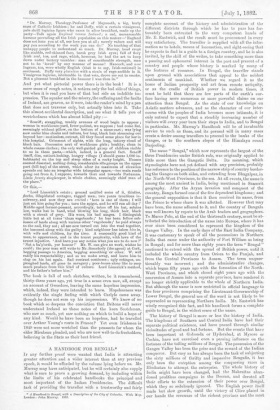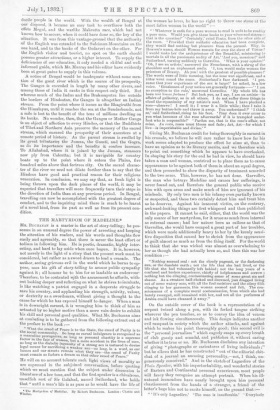A HANDBOOK FOR BENGAL.* Ir. any further proof were wanted
that India is attracting greater attention and a wider interest than at any previous epoch, it would be afforded by the volume lying before us. Mr. Murray may have anticipated, but he will certainly also supply what is sure to prove a growing demand, by including within the limits of his celebrated handbooks the principal and most important of the Indian Presidencies. The difficult task of providing the traveller with a trustworthy and fairly
A Handbook to Bengal, with a Description of the City of Calcutta. With Div. London : John Murray. 1 2.
complete account of the history and administration of the different districts through which he has to pass has for- tunately been entrusted to the very competent hands of Mr. E. Eastwick, and the result must be pronounced in every way satisfactory. The traveller is supplied with all the infor- mation as to hotels, means of locomotion, and sight-seeing that he expects to find in a guide to a foreign country, and he is also invited, by the skill of the writer, to take something more than a passing and ephemeral interest in the past and present of a country and people whose history is marked by many of the features of romance. In Bengal, the traveller stands upon ground with associations that appeal to the noblest sentiments of mankind. Whether we regard it as the home of Indian prosperity and art from remote antiquity, or as the cradle of British power in modern times, it must be held that there are few parts of the earth's sur- face having more numerous or more powerful claims on our attention than Bengal. As the state of our knowledge on Asiatic matters advances, and as the character of our inter- course with the peoples of India becomes more intimate, it is only natural to expect that a steadily increasing number of visitors will every year turn their steps to India, and to Bengal in particular. Mr. Murray's Handbook will be of invaluable service to such as these, and its perusal will in many cases create a desire among travellers to proceed to the banks of the Ganges, or to the southern slopes of the Himalaya round Darjeeling.
The name "Bengal," which now represents the largest of the three Presidencies under British rule, was originally applied to little more than the Gangetic Delta. Its meaning, which etymologists have not yet defined with any precision, probably has reference to the position of the narrow strip of country border- ing the Ganges on both sides, and extending from Bhagalpur, in the North-West Provinces, to the sea. At all events, the name is among the most ancient in India, being mentioned in Sanscrit geography. After the Aryan invasion and conquest of the country, Banga formed one of the five dependent kingdoms ; and the general supposition is that it then received its name, from the Prince to whose share it was allotted. However that may have been, the name adhered to it, and the country of Bangala was well known by repute to the Arab traders and geographers. To Marco Polo, at the end of the thirteenth century, must be at- tributed the introduction of the name into Europe, where it has ever since been considered to represent the kingdom of the Ganges Valley. In the early days of the East India Company, it was customary to speak of all the possessions in Northern India that came under the authority of Port William as being in Bengal ; and for more than eighty years the term " Bengal " continued to extend with the spread of British power, until it included the whole country from Orissa to the Punjab, and from the Central Provinces to Assam, The term unques- tionably was incorrect ; and the administrative changes, which began fifty years ago with the formation of the North- West Provinces, and which closed eight years ago with the conversion of Assam into a separate province, have rendered it no longer strictly applicable to the whole of Northern India. But although the name is now restricted in official language to the four provinces comprising the Lieutenant-Governorship of Lower Bengal, the general use of the word is not likely to be superseded as representing Northern India. Mr. Eastwick has wisely recognised this fact, and his handbook forms a complete guide to Bengal, in the widest sense of the name.
The history of Bengal is more or less the history of India. The kingdoms of Southern and Central India have had their separate political existence, and have passed through similar vicissitudes of good and bad fortune. But the events that have been important at Golconda or Hyderabad, at Mysore or Cochin, have not exercised even a passing influence on the fortunes of the toiling millions of Bengal. The possession of the Ganges Valley has been the prize and the reward of the Indian conqueror. But easy as has always been the task of subjecting the sixty millions of thrifty and impassive Bengalis, it has only been the exception among the conquering races in Hindostan to attempt the enterprise. The whole history of India might have been changed, had the Mahrattaa aban- doned profitless campaigns in the Deccan, and devoted all their efforts to the extension of their power over Bengal, which they so sedulonsly ignored. The English power itself made but slow growth, until the victory of Clive placed. in our hands the revenues of the richest province and the most .docile people in the world. With the wealth of Bengal at our disposal, it became an easy task to overthrow both the effete Mogul, and the warlike Mahratta race, which had not known how to secure, when it could have done so, the key of the situation. It was from this vantage-ground that the authority of the English was extended to the Suleiman Mountains on the one hand, and to the banks of the Godaveri on the other. For the English visitor and tourist, no spot on the earth should possess greater attractions, or a higher interest. To supply the deficiencies of our education, it only needed a skilful and well- informed guide, which Mr. Murray and his editor have evidently been at great pains to supply in this volume.
A notice of Bengal would be inadequate without some men- tion of the great river which is the source of its prosperity. The Ganges is exceeded in length by many other rivers, and among those of India it ranks in this respect only third. But whereas much of the Indus and the Brahmaputra lies outside the borders of Hindostan, the Ganges is altogether an Indian stream. From the point where it issues as the Bhagirathi from the Himalayas, until it reaches the sea at the Sunderbunds, not a mile is lost to the benefit of the tons of millions dwelling on its banks. No wonder, then, that the Ganges or Mother Ganga is an object of affection to every Hindoo, or that the Buddhists of Tibet and Northern Asia preserve the memory of the sacred stream, which ensured the prosperity of their ancestors at a remote period of history. As the parent stream is swelled by its great tributaries the Jumna, the Gumti, and the Gogra, so do its importance and the benefits it confers increase. To Allahabad, where it is joined by the jumna, steamers now ply from Calcutta; but it is navigable for country boats up to the point where it enters the Plains, five hundred miles above that fortress city. On the sacred charac- ter of the river we need not dilate further than to say that the Hindoos have good and practical reason for their religious veneration. In conclusion, we may say that, as fresh light is being thrown upon the dark places of the world, it may be expected that travellers will more frequently turn their steps in the direction of India than at any previous period. In Bengal, travelling can now be accomplished with the greatest degree of comfort, and to the inquiring mind there is much to be learnt of a novel kind, from its past as well as from its present con- dition.



































 Previous page
Previous page